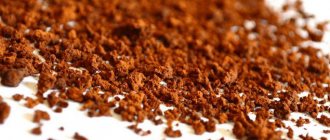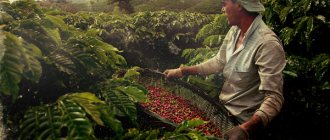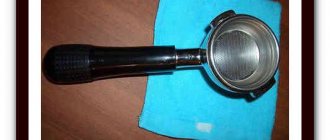Origin of the variety
Liberian coffee originates from West Africa. Today, this species is grown in almost all countries of the African continent, as well as on the islands of Sri Lanka, Indonesia, the Philippines and others. Liberica coffee is obtained from the fruits of coffee trees with very large leaves and a height of 6-10 meters. The length of the coffee bean is 30-35 mm, its width is 10-15 mm. Liberica is resistant to all diseases of coffee trees, except rust fungus. The quality of Liberica fruits is not the highest, the yields are very low, so it is rarely used as a separate variety of coffee. Liberica is most often used to create various mixtures.
Applications of Liberica coffee
As already mentioned, Liberica goes mainly into blends, where it gives other grains an amazing aroma, but only local residents in the regions where it grows make a separate drink from it. However, this variety is also used for other purposes:
- In the confectionery industry. For example, Liberica is often used as a flavoring agent for all coffee-flavored sweets and desserts. There is almost no caffeine, the taste is not too pronounced, but the smell is mind-blowing.
- For the production of jasmine tea. Surprisingly, it is Liberica flowers that smell stronger than the petals of the flower itself, so they are often collected, dried, and either flavored with tea or brewed in their pure form. The finished drink can be distinguished from a natural one only by its brighter aroma and some coffee notes, but this requires professionalism.
In coffee shops you can find coffee blends with Liberica, they are not too expensive, but they are really rare. However, a real coffee lover should try this drink to feel this unusual, bright aroma, which seems almost concentrated. Robusta may not be present in the mixture, but Arabica is a must, as it gives the main taste. But without Robusta the blend will be bland and less crisp, so choose according to your preference.
History of the Liberica variety
This type of coffee was discovered for widespread use only in the 20th century. in Guinea. It was found at the end of the 18th century in the forests of Liberia (hence the name of this species) by Carl Linnaeus' student Adam Afzelius. Later, this species was found in Cote D'Ivoire. Of all the existing botanical varieties of coffee trees, Liberica trees are the most slender and tall (height can reach 18 meters). This coffee tree grows only north of the equator and is very difficult to find on plantations. Liberica makes up only 2% of the coffee trees grown on coffee plantations. However, the reason for such unpopularity of this botanical variety is not at all the climatic preferences of the Liberica coffee tree - the drink made from Liberica beans has an unsaturated, “empty” taste and is not in demand among coffee lovers. The caffeine content of Liberica can vary from 0.7% to 2.4%. This type of coffee is used mainly in the confectionery industry, therefore, when talking about the types of coffee used to prepare the popular drink, liberica is usually not mentioned at all.
History of the variety and characteristics of growth
The variety was discovered only at the end of the 18th century in Liberia, where it received its name. But for many years it was unknown to the general consumer and coffee production, until in the 20th century in Guinea they began to actively add it to blends. However, only 2% of such trees still grow on plantations; they mostly grow freely throughout Africa, in the northern half of the equator.
In Africa and Malaysia, Liberica is not cultivated at all; it grows wild. In the Philippines, it is mixed with Arabica, varieties are cultivated, and it is used more often.
The trees are small, up to 10 meters high, more often 6-8 meters. The grains are very large, about 25-35 mm, wide - up to 15 mm in length. The trees are demanding in terms of conditions, they require relatively high humidity, but at the same time they are quite resistant to diseases, are not afraid of insects, and do not require special care or treatment. However, under unfavorable conditions they simply do not bear fruit, instead of drying out and waiting for a new season. If the rainy season comes after a long drought, the tree can “come to life” and bear a harvest.
You can confuse any other types of coffee beans, but you can definitely distinguish Liberica - the beans are simply huge compared to ordinary ones, 3-4 times larger than Arabica, and almost 5 times larger than Robusta.

Productivity is low, depends on the season and conditions, in some seasons the trees may not produce fruit at all or only the bare minimum and of poor quality, but that is not why Liberica coffee is not sold in stores, but solely because it has “empty”, “ diluted”, “unexpressed” taste and contains little caffeine - about 0.8-1.2%.
Delightful aroma, but what about the taste?
The smell of these beans is strong, deep and rich, superior in its characteristics to the aroma of Arabica, for which it is appreciated by coffee lovers. However, the taste of the drink made from Liberica beans is considered “empty”. It is not rich and also has some bitterness. The caffeine content in beans is 0.7-2.4%.
Most of the harvest is processed at the point of collection, mainly used for the needs of the confectionery industry and for creating blends. Mixtures containing liberica have a pronounced aroma, and other components provide the necessary taste characteristics.
Liberica coffee plantations are less represented than other coffee varieties, but the beans' vibrant aroma makes them suitable for use in mixed formulations. The grains themselves are rarely found in their pure form outside the countries in which they grow, as they are processed on their territory.
photo: depositphotos.com/VikaKhalabuzar
About the type of liberica
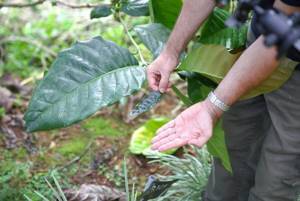
Liberica is a unicorn in the coffee world: there is a lot of talk about it, but few have seen or tried it. This is a separate species that stands out primarily for its size. The height of an adult tree reaches 20 meters, the leaves are 20-30 times larger than Arabica leaves, and the berries are also larger. The time until Liberica berries fully ripen is 14 months versus 9 months for Arabica. Coffea diversa uses ladders to harvest crops.
This type of caffeine contains the same amount as most Arabica beans, 1.2-1.3%, and there is more caffeine in the leaves than in the beans themselves. In some countries, an infusion of the leaves is drunk, but the flowers are most prized for their intense and deep jasmine aroma. The flowers make wonderful jasmine tea.

Liberica is almost never grown in its pure form, because its taste is peculiar and unusual, but in the Philippines it is often mixed with Arabica. In Malaysia and West Africa, where Liberica comes from, they also do not pay much attention to it.
Benefits of Liberica
Liberica has excellent external characteristics and is considered the most beautiful coffee tree in the whole world. It reaches a length of 10 meters or more and has very large, beautiful leaves that look like a fan. Sometimes you can find trees up to 18 meters high. Its berries have a smooth, elongated shape and are almost twice the size of Arabica beans. One coffee bean reaches 3-4 centimeters in length and 1-1.5 centimeters in width.
In addition, Liberica is good for its unpretentiousness. These trees are quite resistant to adverse factors and grow ideally in hot temperatures and high humidity. Liberica is very resistant to various diseases that often affect coffee trees. She is also not afraid of any insects. The only danger is rust fungus. From a processing point of view, it is very economical and does not require any special costs.
Still, growing Liberica is not considered a very profitable activity, since it cannot produce a good harvest. It also cannot boast of excellent taste. The drink brewed from Liberica beans turns out weak and empty. That is why liberica is not used in its pure form. The drink is not strong enough, caffeine ranges from 0.7-2.4%. A too bitter, watery drink is unlikely to please any coffee gourmet, even despite the delightful qualities of the aroma.
Although Liberica is not consumed in its pure form, it is quite in demand when preparing mixtures. It produces luxurious blends, the highlight of which is the extraordinary aroma of liberica. However, due to the sharp bitter taste, it is recommended to add very little even in the mixture.
Thanks to its use in the confectionery and coffee industries, Liberica continues to be widely grown, although not in the same way as Arabica or Robusta.
Liberica
Coffee beans are divided by size, shape, color, taste, region of growth, growing methods and of course by variety. Thanks to the clever work of marketers, the world is familiar with the two most popular varieties of coffee, Arabica and Robusta, but in fairness, it is worth noting that this list does not end there. Today we will talk about the third most common type of coffee in the world, the turnover of which on the international coffee market is only 1%.
Liberica coffee variety
Liberica - a coffee variety first bred in Liberia (West Africa) - is the third most important coffee variety in the world, after Arabica and Robusta, but despite this, it has many advantages, such as low caffeine content, which is important, rich taste and a characteristic aroma only for this type of coffee. Liberica is usually used only in those countries where it grows. Therefore, it is not as common as other varieties. 80% of the coffee harvest goes to the confectionery industry, and only 20% to the coffee industry.
The coffee tree can reach a height of 18 m. It is an evergreen shrub with dimorphic branching and large leaves, approximately 14 to 25 cm in length and 5 to 9 cm in width, of a dark green color. Coffee made from Liberica beans has a characteristic bitter taste, which is why it is not used in its pure form. It is usually used as one of the ingredients in coffee blends or as an additive that gives a special aroma.
When dry, Liberica coffee beans contain about 0.5-1.8% caffeine.
Composition per 100 g of product:
- water 11 g,
- protein 14 g,
- sucrose and reducing sugars 8 g,
- cellulose and polysaccharides 42 g,
- lipids 12 g,
- chlorogenic acids 7 g,
- ash 4 g.
- caffeine 1.6 g.
Weight of 1000 seeds is approximately 575 g.
The coffee tree is not afraid of insects. Its unpretentiousness can easily be considered its biggest advantage, since the plant does not need to be treated with any pesticides or other potentially hazardous substances. True, cultivation of liberica is not a profitable activity due to its low yield. Liberica is used very rarely in its pure form. But, as for the production of various mixtures, it is better not to find it. Liberica is often used to make instant coffee and brewed coffee bags.
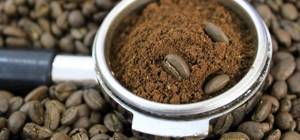
A little history
This variety of coffee was first discovered three centuries ago in the forests of Liberia, a state located on the western coast of Africa, after which it received its name. The first plantation appeared in 1864, but the first mentions date back to 1792. During the Spanish colonial era of the 1800s, Liberica was brought and planted in Lipa, Philippines, and a little later in the late 19th century, the beans were brought to Indonesia to replace Arabica, which was destroyed by bad weather conditions.
Today, Liberica is grown and widely used in Guyana, Suriname, Bioko (Fernando Po), Sao Tome, Liberia, Malaysia in the Philippines and to a lesser extent in Sierra Leone, Ivory Coast, Nigeria, Congo (Brazzaville), Mauritius , Sri Lanka, India, Thailand, Vietnam, Taiwan and Timor.
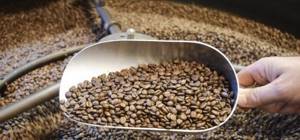
History of Liberica Cultivation
Liberica was discovered and described at the end of the 18th century by the botanist Adam Afzelius, a student of Carl Linnaeus. It is reliably known that in 1864 this type of coffee was already grown in Liberia. But there is information that the first plantations were founded back in 1792.
Liberica was exported outside of Africa in the second half of the 19th century (around the 70s), when plantations in Asia were affected by coffee rust. Landowners hoped that the unpretentious Liberica would replace Arabica. However, the new species turned out to be only slightly less susceptible to the disease, and also less productive, so Liberica was soon replaced by Robusta.
Article on the topic: Field maple description and features
Due to the aroma of liberica, it is used in the confectionery industry. In Europe and the USA, sometimes a little (3-5%) Liberica is added to mixtures with Arabica.

